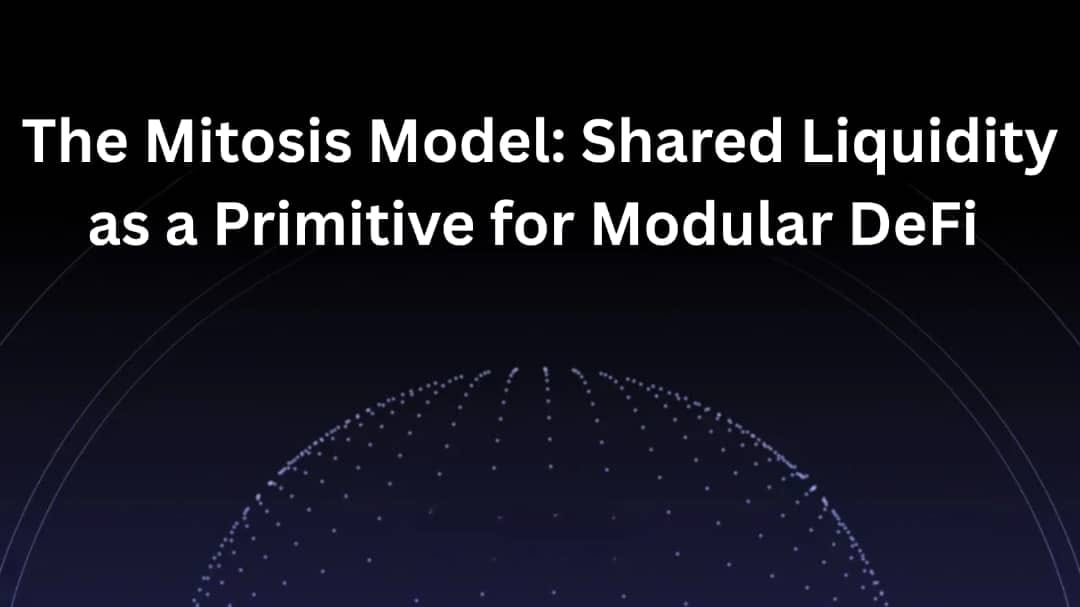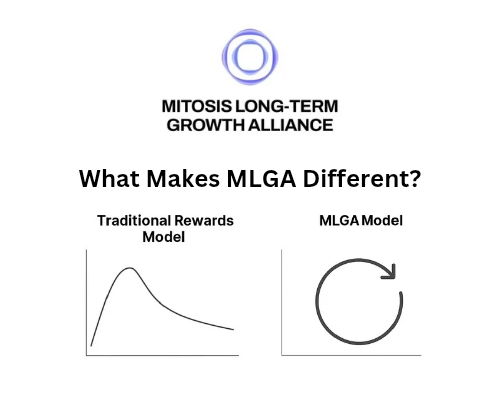The Mitosis Model: Shared Liquidity as a Primitive for Modular DeFi

Introduction
The decentralized finance (DeFi) ecosystem is rapidly evolving, with new innovations emerging to address the challenges of liquidity fragmentation and cross-chain interactions. Traditional bridges have served as a means to transfer assets between different blockchain networks, but they often come with security vulnerabilities, high fees, and complex user experiences. Enter Mitosis a revolutionary model that redefines the concept of liquidity coordination in DeFi. Mitosis is not just a bridge; it is a new liquidity coordination layer that integrates seamlessly with rollups and modular architectures, enabling shared liquidity as a fundamental primitive for modular DeFi. This article explores the Mitosis model, its functionalities, and its potential to reshape the DeFi ecosystem.
1. Understanding the Need for Mitosis
1.1 The Limitations of Traditional Bridges
Traditional bridges have played a crucial role in enabling cross-chain interactions, but they come with several limitations:
- Security Vulnerabilities: Bridges can be susceptible to hacks and exploits, as seen in various high-profile incidents in the DeFi space. For example, the Poly Network hack in 2021 resulted in the loss of over $600 million due to vulnerabilities in the bridge's smart contracts.
- Liquidity Fragmentation: Users may face difficulties accessing liquidity across different chains, leading to inefficiencies and higher transaction costs. Wrapped assets can create silos of liquidity, making it challenging for users to find the best prices.
- Complex User Experience: Navigating multiple platforms and wrapped assets can create a cumbersome experience for users, deterring participation in DeFi. The need to understand the mechanics of wrapping and unwrapping assets adds unnecessary complexity.
- High Fees: Transferring assets across chains can incur significant transaction fees, especially during periods of high network congestion. Users may find themselves paying high gas fees for simple asset transfers.
1.2 The Emergence of Modular DeFi
Modular DeFi refers to a new approach to decentralized finance that emphasizes the use of modular components and protocols to create a more flexible and efficient ecosystem. This approach allows developers to build DeFi applications that can easily integrate with various protocols and services, promoting interoperability and innovation.
2. The Mitosis Model: A New Paradigm for Liquidity Coordination
2.1 What is Mitosis?
Mitosis is a next-generation liquidity coordination layer designed to facilitate shared liquidity across multiple blockchain networks. Unlike traditional bridges, Mitosis enables users to access liquidity directly on their native chains, optimizing asset flows and enhancing the overall DeFi experience. The Mitosis model is built on the principles of modularity and interoperability, making it a perfect fit for the evolving landscape of DeFi.
2.2 Key Features of the Mitosis Model
- Shared Liquidity: Mitosis allows for the creation of shared liquidity pools that can be accessed by multiple blockchain networks. This shared liquidity model enhances capital efficiency and reduces fragmentation, enabling users to access deeper markets.
- Dynamic Liquidity Routing: Mitosis employs advanced algorithms to analyze liquidity across various platforms and route trades to the most efficient sources. This dynamic routing minimizes slippage and ensures that users receive the best available prices.
- Interoperability with Rollups: Mitosis is designed to work seamlessly with rollups and modular architectures, allowing for efficient asset transfers and interactions across different chains. This interoperability promotes a more cohesive DeFi ecosystem.
- Risk Management Strategies: Mitosis incorporates risk minimization strategies, such as slippage control and liquidity depth analysis, to enhance the security and efficiency of trades. Users can set slippage limits to protect themselves from unfavorable price movements during trade execution.
- User -Friendly Interface: Mitosis provides a seamless user experience, allowing users to execute trades effortlessly across different chains. The unified interface simplifies the process of accessing liquidity, making DeFi more accessible to a broader audience.
2.3 How Mitosis Works
Mitosis operates by connecting various blockchain networks through a shared liquidity model. Here’s a step-by-step breakdown of how the Mitosis model functions:
- Liquidity Pool Creation: Users can contribute assets to shared liquidity pools that are accessible across multiple chains. These pools are designed to optimize capital efficiency and reduce fragmentation.
- Dynamic Price Aggregation: Mitosis continuously monitors prices across various decentralized exchanges (DEXs) and liquidity pools, ensuring that users receive the best available rates for their trades.
- Trade Execution: When a user initiates a trade, Mitosis analyzes the available liquidity and routes the trade to the most efficient source, minimizing slippage and optimizing execution.
- Cross-Chain Interactions: Mitosis facilitates seamless interactions between different blockchain networks, allowing users to access liquidity without the need for wrapping assets or using traditional bridges.
- Risk Management: Mitosis incorporates risk management strategies to protect users from unfavorable price movements and ensure the integrity of trades.
3. The Role of Mitosis in Modular DeFi
3.1 Shared Liquidity as a Primitive
Shared liquidity is a fundamental primitive for modular DeFi, as it enables different protocols and applications to access liquidity from a common pool. This shared liquidity model offers several advantages:
- Capital Efficiency: By pooling liquidity across multiple chains and protocols, shared liquidity enhances capital efficiency, allowing users to access deeper markets and better prices.
- Reduced Fragmentation: Shared liquidity reduces the fragmentation of liquidity across different platforms, making it easier for users to find the best trading opportunities.
- Enhanced Interoperability: Shared liquidity promotes interoperability between different DeFi protocols, enabling seamless interactions and collaborations.
- Simplified User Experience: By providing a unified liquidity source, shared liquidity simplifies the user experience, making it easier for users to engage with DeFi applications.
3.2 Mitosis as a Liquidity Coordination Layer
Mitosis serves as a liquidity coordination layer that fits perfectly within the modular DeFi ecosystem. Its shared liquidity model allows for efficient asset transfers and interactions across different blockchain networks, promoting a more cohesive and interconnected DeFi landscape.
- Integration with Rollups: Mitosis is designed to work seamlessly with rollups, enabling efficient asset transfers and interactions between layer 1 and layer 2 solutions. This integration enhances the overall scalability and efficiency of DeFi applications.
- Collaboration with Other Protocols: Mitosis can collaborate with other DeFi protocols to create a more interconnected ecosystem. By providing shared liquidity, Mitosis enables different protocols to access a common pool of liquidity, fostering innovation and collaboration.
- Support for Composability: Mitosis promotes composability within the DeFi ecosystem, allowing developers to build applications that can easily integrate with various protocols and services. This composability enhances the overall user experience and encourages greater participation in DeFi.
4. Use Cases of the Mitosis Model
1. Cross-Chain Trading
Mitosis enables users to trade assets seamlessly across different blockchain networks without the need for wrapping or bridging. This cross-chain trading capability enhances liquidity access and reduces slippage, providing users with better trading conditions.
2. Liquidity Provisioning
Liquidity providers can contribute to shared liquidity pools on Mitosis, earning rewards without the risks associated with traditional bridges. This liquidity provisioning model encourages greater participation in DeFi and enhances overall market depth.
3. Decentralized Applications (DApps)
Developers can build decentralized applications that leverage Mitosis's liquidity coordination capabilities, enhancing user experience and accessibility. By integrating with Mitosis, DApps can access a wider range of liquidity sources and provide users with better trading opportunities.
4. Yield Farming
Mitosis can facilitate yield farming strategies by allowing users to access liquidity from multiple chains. Users can optimize their yield farming strategies by leveraging shared liquidity, enhancing capital efficiency and returns.
5. Challenges and Considerations
1. Technical Complexity
Implementing the Mitosis model requires significant technical expertise and resources. Developers must navigate various challenges to create efficient solutions that can handle cross-chain liquidity routing and shared liquidity management.
2. Security Risks
While Mitosis reduces some risks associated with traditional bridges, it introduces new challenges related to cross-chain communication and interoperability. Ensuring the security of user funds and transactions is critical to maintaining trust in the system.
3. Market Fragmentation
The rise of multiple liquidity coordination layers can lead to market fragmentation, making it challenging for users to navigate the landscape. Ongoing efforts are needed to promote collaboration among protocols and create a more cohesive ecosystem.
4. Regulatory Considerations
As the DeFi landscape evolves, regulatory scrutiny may increase. Mitosis and other bridgeless DeFi protocols must ensure compliance with existing regulations while fostering innovation and user participation.
6. The Future of Mitosis and Bridgeless DeFi
Trends to Watch
- Increased Adoption of Shared Liquidity Solutions: As users become more aware of the limitations of traditional bridging solutions, the demand for shared liquidity protocols like Mitosis will grow.
- Interoperability Initiatives: Collaborative efforts among DeFi protocols to enhance interoperability will pave the way for more efficient liquidity routing solutions.
- Community-Driven Innovations: The establishment of community-driven liquidity solutions will likely reflect the needs and preferences of users, fostering greater participation in DeFi.
- Regulatory Developments: As the DeFi landscape evolves, regulatory frameworks will need to adapt to address the challenges posed by bridgeless DeFi solutions. Protocols that prioritize compliance and transparency will be better positioned for long-term success.
Conclusion
The Mitosis model represents a transformative shift in the decentralized finance landscape, enabling shared liquidity as a fundamental primitive for modular DeFi. By optimizing liquidity routing and enhancing security, Mitosis is paving the way for a more efficient and user-friendly DeFi experience. As the demand for bridgeless solutions continues to grow, we can expect to see significant advancements in the DeFi ecosystem, ultimately leading to a more interconnected and accessible financial landscape.

Comments ()